People Management in Easy Jet: A MG411 Report, January 2020
VerifiedAdded on 2023/01/13
|10
|2730
|8
Report
AI Summary
This report examines the people management strategies employed by Easy Jet, a low-cost British airline, focusing on leadership and management, training and development, and talent management. The report begins with an introduction to Easy Jet's organizational context and its human resource management team. The main body of the report then delves into three key areas. Area 1 explores leadership and management, analyzing the operational context, relevant theoretical models (such as Trait Theory and Contingent Theory), and providing recommendations for improving management skills through training and fostering positive employee relations. Area 2 focuses on training and development, examining the operational context, relevant models (such as System Model Training and Transitional Model), and recommending various training opportunities. Area 3 investigates talent management, discussing the operational context, relevant models (including planning, attracting, developing, retaining, and transitioning talent), and suggesting strategies for retaining talent. The report concludes by summarizing the findings and emphasizing the importance of these people management practices for enhancing employee performance and overall organizational success within Easy Jet.
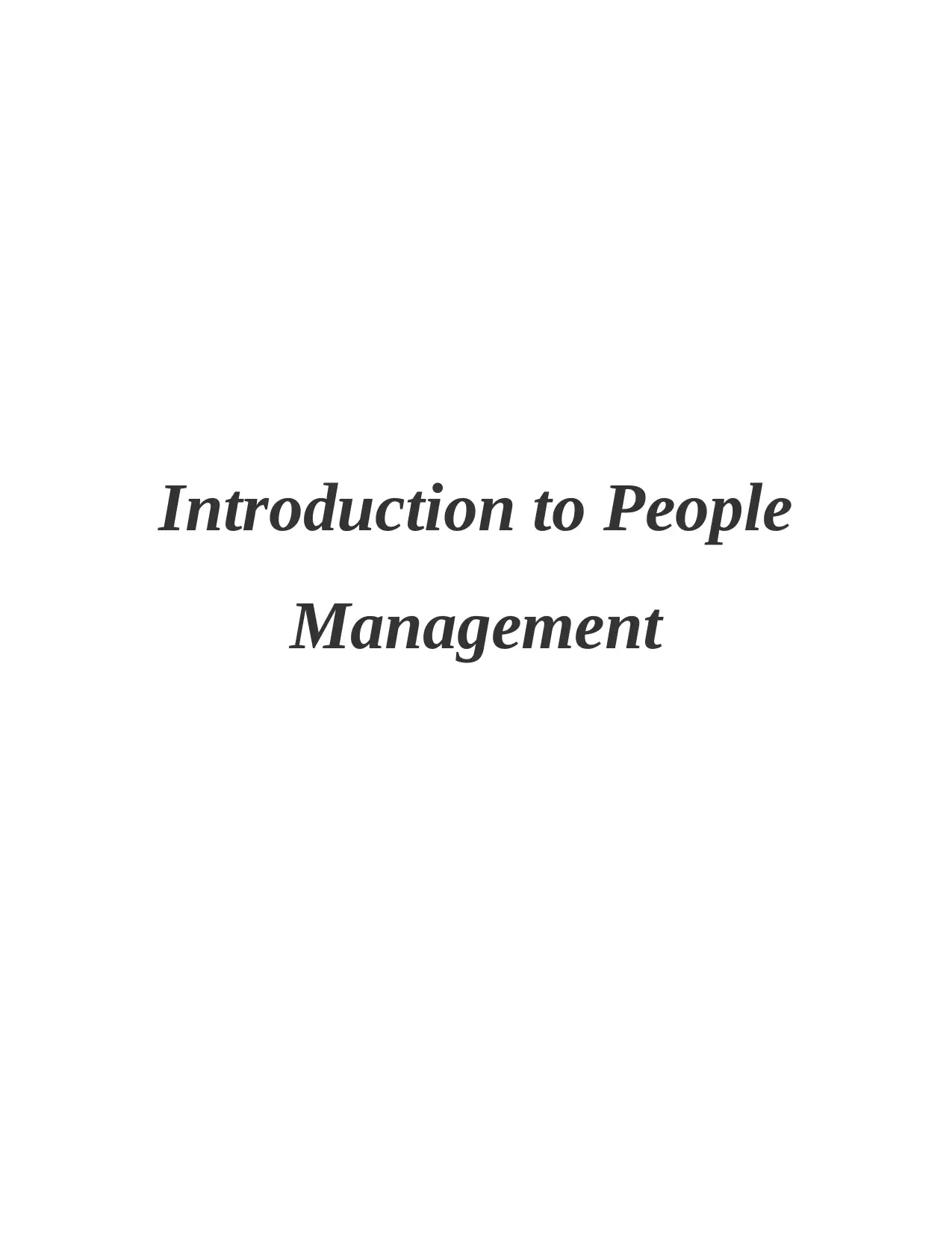
Introduction to People
Management
Management
Paraphrase This Document
Need a fresh take? Get an instant paraphrase of this document with our AI Paraphraser
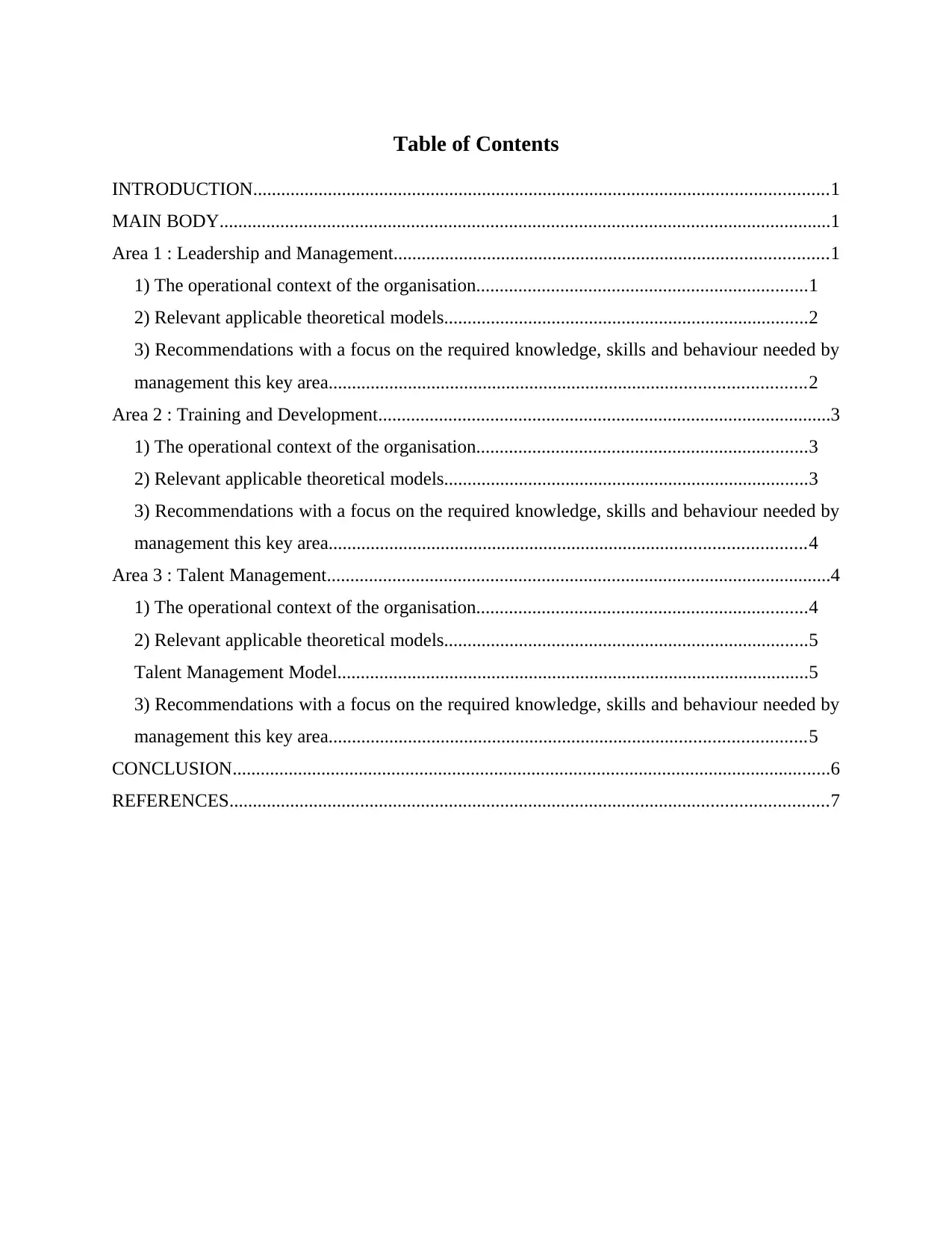
Table of Contents
INTRODUCTION...........................................................................................................................1
MAIN BODY...................................................................................................................................1
Area 1 : Leadership and Management.............................................................................................1
1) The operational context of the organisation.......................................................................1
2) Relevant applicable theoretical models..............................................................................2
3) Recommendations with a focus on the required knowledge, skills and behaviour needed by
management this key area......................................................................................................2
Area 2 : Training and Development.................................................................................................3
1) The operational context of the organisation.......................................................................3
2) Relevant applicable theoretical models..............................................................................3
3) Recommendations with a focus on the required knowledge, skills and behaviour needed by
management this key area......................................................................................................4
Area 3 : Talent Management............................................................................................................4
1) The operational context of the organisation.......................................................................4
2) Relevant applicable theoretical models..............................................................................5
Talent Management Model.....................................................................................................5
3) Recommendations with a focus on the required knowledge, skills and behaviour needed by
management this key area......................................................................................................5
CONCLUSION................................................................................................................................6
REFERENCES................................................................................................................................7
INTRODUCTION...........................................................................................................................1
MAIN BODY...................................................................................................................................1
Area 1 : Leadership and Management.............................................................................................1
1) The operational context of the organisation.......................................................................1
2) Relevant applicable theoretical models..............................................................................2
3) Recommendations with a focus on the required knowledge, skills and behaviour needed by
management this key area......................................................................................................2
Area 2 : Training and Development.................................................................................................3
1) The operational context of the organisation.......................................................................3
2) Relevant applicable theoretical models..............................................................................3
3) Recommendations with a focus on the required knowledge, skills and behaviour needed by
management this key area......................................................................................................4
Area 3 : Talent Management............................................................................................................4
1) The operational context of the organisation.......................................................................4
2) Relevant applicable theoretical models..............................................................................5
Talent Management Model.....................................................................................................5
3) Recommendations with a focus on the required knowledge, skills and behaviour needed by
management this key area......................................................................................................5
CONCLUSION................................................................................................................................6
REFERENCES................................................................................................................................7

⊘ This is a preview!⊘
Do you want full access?
Subscribe today to unlock all pages.

Trusted by 1+ million students worldwide
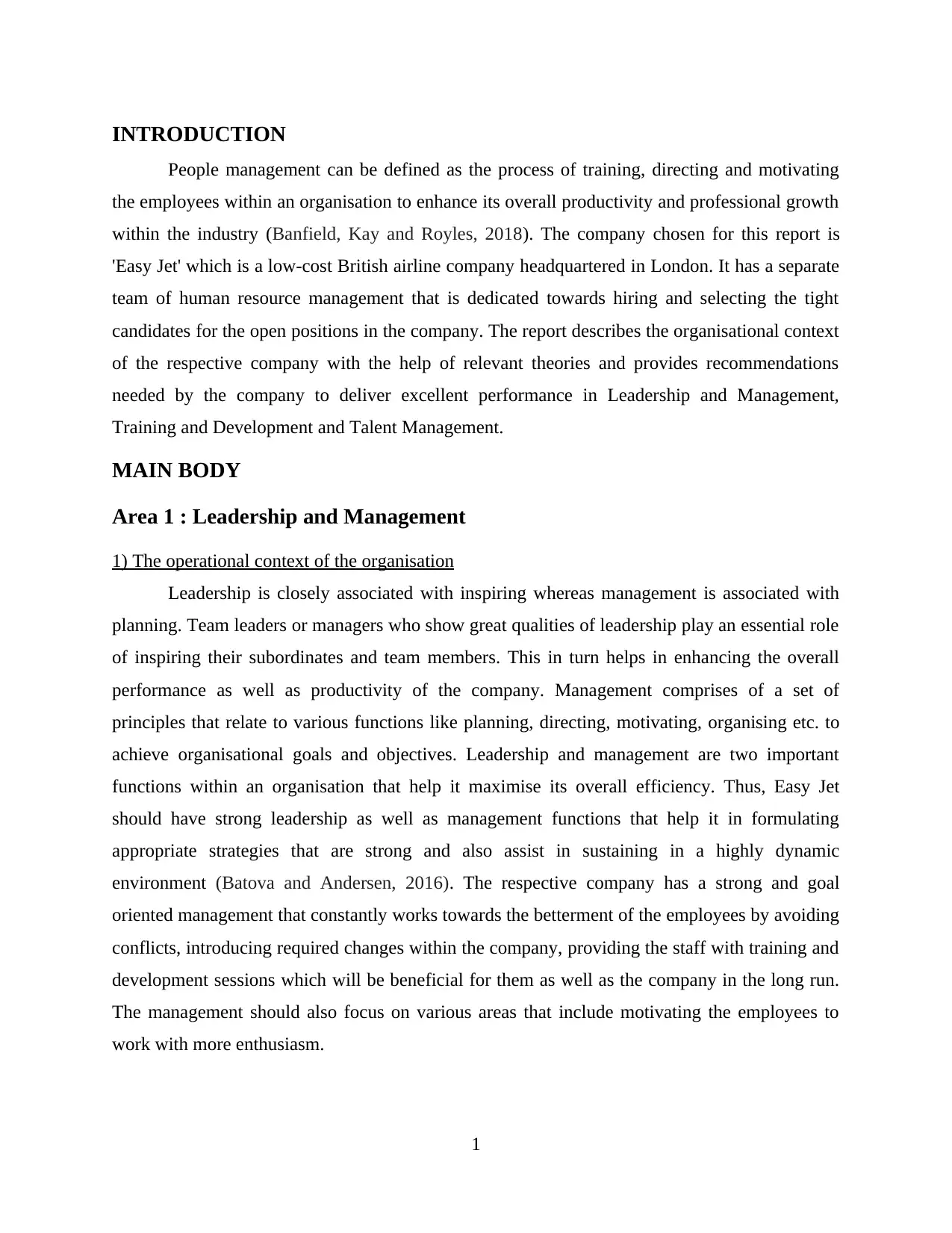
INTRODUCTION
People management can be defined as the process of training, directing and motivating
the employees within an organisation to enhance its overall productivity and professional growth
within the industry (Banfield, Kay and Royles, 2018). The company chosen for this report is
'Easy Jet' which is a low-cost British airline company headquartered in London. It has a separate
team of human resource management that is dedicated towards hiring and selecting the tight
candidates for the open positions in the company. The report describes the organisational context
of the respective company with the help of relevant theories and provides recommendations
needed by the company to deliver excellent performance in Leadership and Management,
Training and Development and Talent Management.
MAIN BODY
Area 1 : Leadership and Management
1) The operational context of the organisation
Leadership is closely associated with inspiring whereas management is associated with
planning. Team leaders or managers who show great qualities of leadership play an essential role
of inspiring their subordinates and team members. This in turn helps in enhancing the overall
performance as well as productivity of the company. Management comprises of a set of
principles that relate to various functions like planning, directing, motivating, organising etc. to
achieve organisational goals and objectives. Leadership and management are two important
functions within an organisation that help it maximise its overall efficiency. Thus, Easy Jet
should have strong leadership as well as management functions that help it in formulating
appropriate strategies that are strong and also assist in sustaining in a highly dynamic
environment (Batova and Andersen, 2016). The respective company has a strong and goal
oriented management that constantly works towards the betterment of the employees by avoiding
conflicts, introducing required changes within the company, providing the staff with training and
development sessions which will be beneficial for them as well as the company in the long run.
The management should also focus on various areas that include motivating the employees to
work with more enthusiasm.
1
People management can be defined as the process of training, directing and motivating
the employees within an organisation to enhance its overall productivity and professional growth
within the industry (Banfield, Kay and Royles, 2018). The company chosen for this report is
'Easy Jet' which is a low-cost British airline company headquartered in London. It has a separate
team of human resource management that is dedicated towards hiring and selecting the tight
candidates for the open positions in the company. The report describes the organisational context
of the respective company with the help of relevant theories and provides recommendations
needed by the company to deliver excellent performance in Leadership and Management,
Training and Development and Talent Management.
MAIN BODY
Area 1 : Leadership and Management
1) The operational context of the organisation
Leadership is closely associated with inspiring whereas management is associated with
planning. Team leaders or managers who show great qualities of leadership play an essential role
of inspiring their subordinates and team members. This in turn helps in enhancing the overall
performance as well as productivity of the company. Management comprises of a set of
principles that relate to various functions like planning, directing, motivating, organising etc. to
achieve organisational goals and objectives. Leadership and management are two important
functions within an organisation that help it maximise its overall efficiency. Thus, Easy Jet
should have strong leadership as well as management functions that help it in formulating
appropriate strategies that are strong and also assist in sustaining in a highly dynamic
environment (Batova and Andersen, 2016). The respective company has a strong and goal
oriented management that constantly works towards the betterment of the employees by avoiding
conflicts, introducing required changes within the company, providing the staff with training and
development sessions which will be beneficial for them as well as the company in the long run.
The management should also focus on various areas that include motivating the employees to
work with more enthusiasm.
1
Paraphrase This Document
Need a fresh take? Get an instant paraphrase of this document with our AI Paraphraser
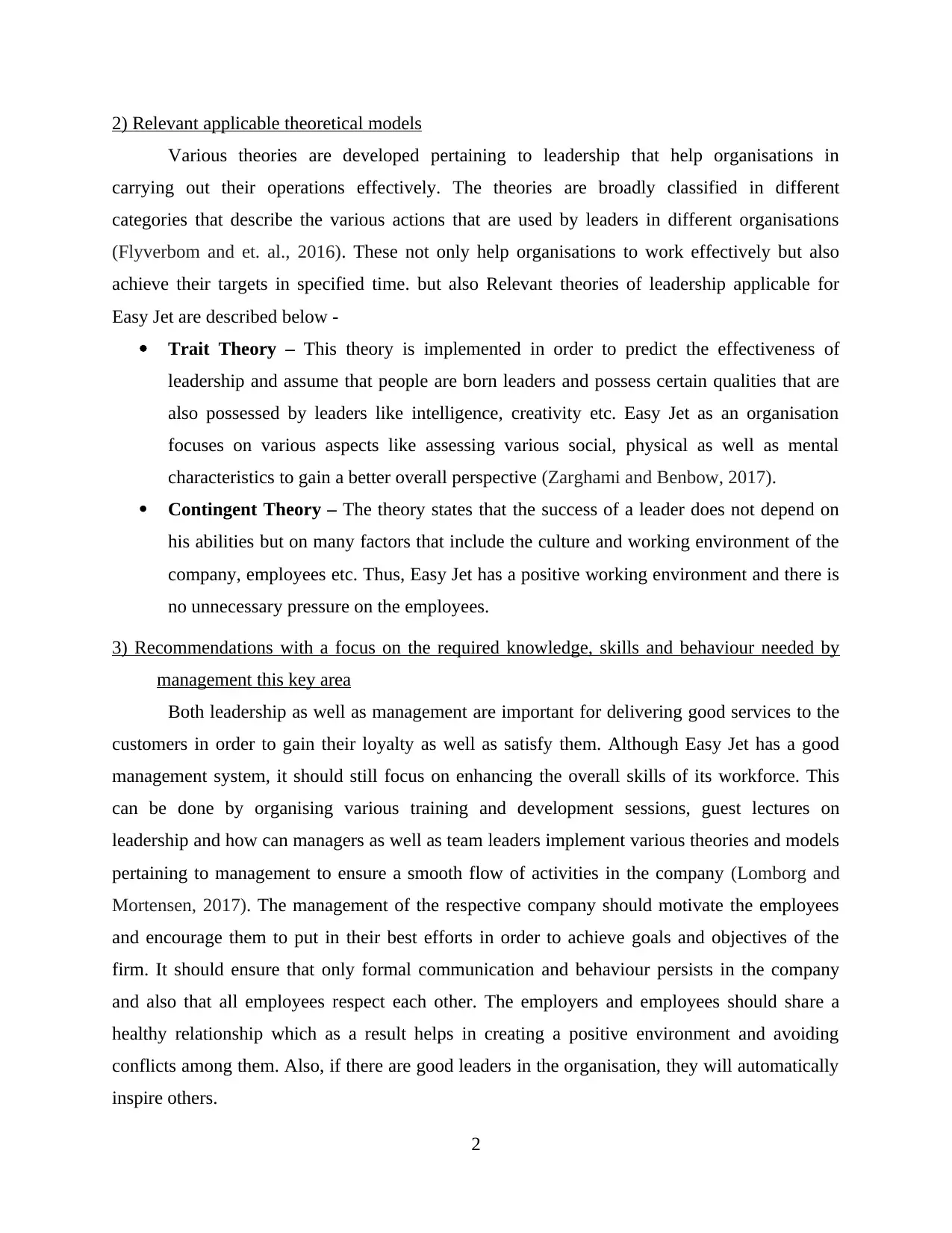
2) Relevant applicable theoretical models
Various theories are developed pertaining to leadership that help organisations in
carrying out their operations effectively. The theories are broadly classified in different
categories that describe the various actions that are used by leaders in different organisations
(Flyverbom and et. al., 2016). These not only help organisations to work effectively but also
achieve their targets in specified time. but also Relevant theories of leadership applicable for
Easy Jet are described below -
Trait Theory – This theory is implemented in order to predict the effectiveness of
leadership and assume that people are born leaders and possess certain qualities that are
also possessed by leaders like intelligence, creativity etc. Easy Jet as an organisation
focuses on various aspects like assessing various social, physical as well as mental
characteristics to gain a better overall perspective (Zarghami and Benbow, 2017).
Contingent Theory – The theory states that the success of a leader does not depend on
his abilities but on many factors that include the culture and working environment of the
company, employees etc. Thus, Easy Jet has a positive working environment and there is
no unnecessary pressure on the employees.
3) Recommendations with a focus on the required knowledge, skills and behaviour needed by
management this key area
Both leadership as well as management are important for delivering good services to the
customers in order to gain their loyalty as well as satisfy them. Although Easy Jet has a good
management system, it should still focus on enhancing the overall skills of its workforce. This
can be done by organising various training and development sessions, guest lectures on
leadership and how can managers as well as team leaders implement various theories and models
pertaining to management to ensure a smooth flow of activities in the company (Lomborg and
Mortensen, 2017). The management of the respective company should motivate the employees
and encourage them to put in their best efforts in order to achieve goals and objectives of the
firm. It should ensure that only formal communication and behaviour persists in the company
and also that all employees respect each other. The employers and employees should share a
healthy relationship which as a result helps in creating a positive environment and avoiding
conflicts among them. Also, if there are good leaders in the organisation, they will automatically
inspire others.
2
Various theories are developed pertaining to leadership that help organisations in
carrying out their operations effectively. The theories are broadly classified in different
categories that describe the various actions that are used by leaders in different organisations
(Flyverbom and et. al., 2016). These not only help organisations to work effectively but also
achieve their targets in specified time. but also Relevant theories of leadership applicable for
Easy Jet are described below -
Trait Theory – This theory is implemented in order to predict the effectiveness of
leadership and assume that people are born leaders and possess certain qualities that are
also possessed by leaders like intelligence, creativity etc. Easy Jet as an organisation
focuses on various aspects like assessing various social, physical as well as mental
characteristics to gain a better overall perspective (Zarghami and Benbow, 2017).
Contingent Theory – The theory states that the success of a leader does not depend on
his abilities but on many factors that include the culture and working environment of the
company, employees etc. Thus, Easy Jet has a positive working environment and there is
no unnecessary pressure on the employees.
3) Recommendations with a focus on the required knowledge, skills and behaviour needed by
management this key area
Both leadership as well as management are important for delivering good services to the
customers in order to gain their loyalty as well as satisfy them. Although Easy Jet has a good
management system, it should still focus on enhancing the overall skills of its workforce. This
can be done by organising various training and development sessions, guest lectures on
leadership and how can managers as well as team leaders implement various theories and models
pertaining to management to ensure a smooth flow of activities in the company (Lomborg and
Mortensen, 2017). The management of the respective company should motivate the employees
and encourage them to put in their best efforts in order to achieve goals and objectives of the
firm. It should ensure that only formal communication and behaviour persists in the company
and also that all employees respect each other. The employers and employees should share a
healthy relationship which as a result helps in creating a positive environment and avoiding
conflicts among them. Also, if there are good leaders in the organisation, they will automatically
inspire others.
2
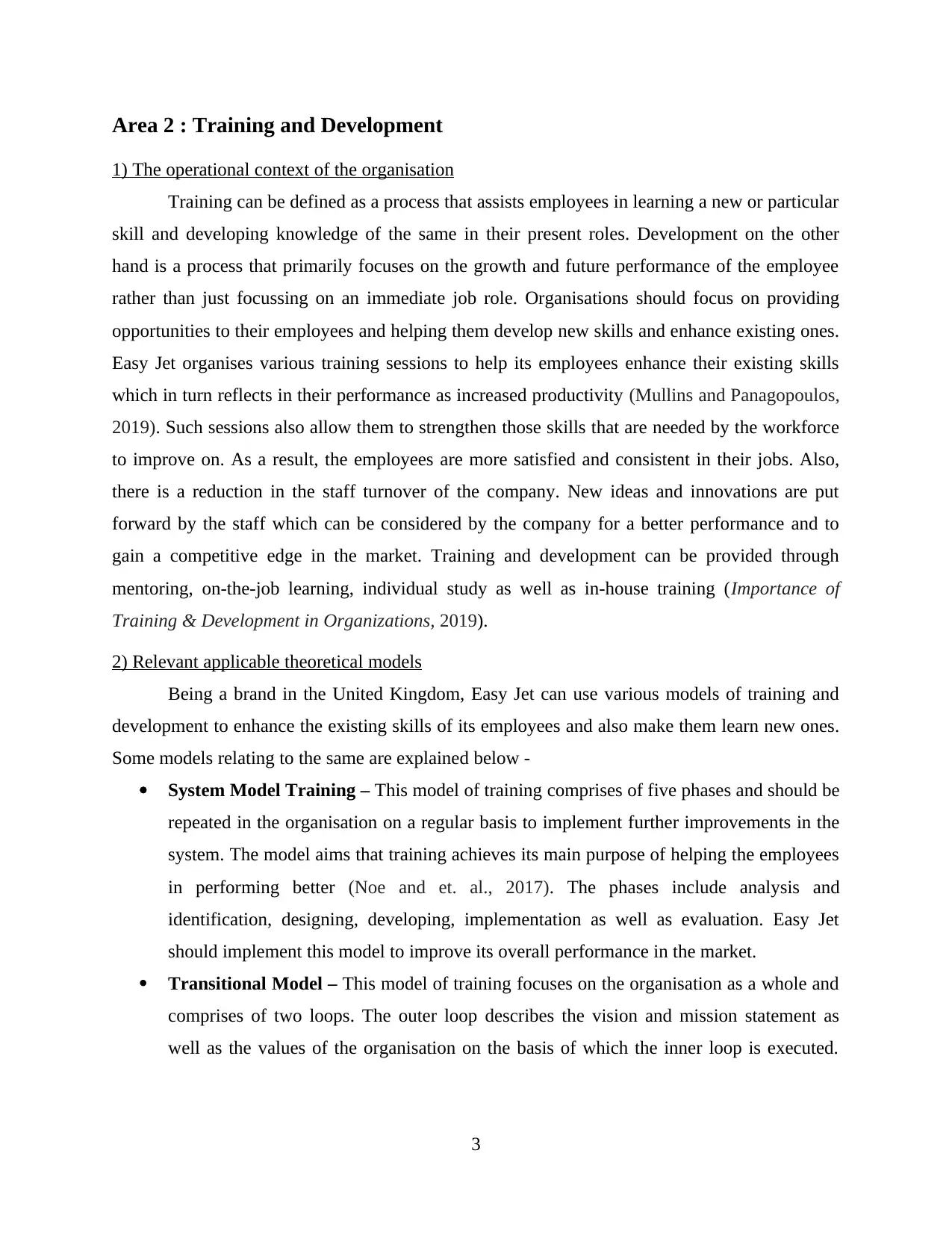
Area 2 : Training and Development
1) The operational context of the organisation
Training can be defined as a process that assists employees in learning a new or particular
skill and developing knowledge of the same in their present roles. Development on the other
hand is a process that primarily focuses on the growth and future performance of the employee
rather than just focussing on an immediate job role. Organisations should focus on providing
opportunities to their employees and helping them develop new skills and enhance existing ones.
Easy Jet organises various training sessions to help its employees enhance their existing skills
which in turn reflects in their performance as increased productivity (Mullins and Panagopoulos,
2019). Such sessions also allow them to strengthen those skills that are needed by the workforce
to improve on. As a result, the employees are more satisfied and consistent in their jobs. Also,
there is a reduction in the staff turnover of the company. New ideas and innovations are put
forward by the staff which can be considered by the company for a better performance and to
gain a competitive edge in the market. Training and development can be provided through
mentoring, on-the-job learning, individual study as well as in-house training (Importance of
Training & Development in Organizations, 2019).
2) Relevant applicable theoretical models
Being a brand in the United Kingdom, Easy Jet can use various models of training and
development to enhance the existing skills of its employees and also make them learn new ones.
Some models relating to the same are explained below -
System Model Training – This model of training comprises of five phases and should be
repeated in the organisation on a regular basis to implement further improvements in the
system. The model aims that training achieves its main purpose of helping the employees
in performing better (Noe and et. al., 2017). The phases include analysis and
identification, designing, developing, implementation as well as evaluation. Easy Jet
should implement this model to improve its overall performance in the market.
Transitional Model – This model of training focuses on the organisation as a whole and
comprises of two loops. The outer loop describes the vision and mission statement as
well as the values of the organisation on the basis of which the inner loop is executed.
3
1) The operational context of the organisation
Training can be defined as a process that assists employees in learning a new or particular
skill and developing knowledge of the same in their present roles. Development on the other
hand is a process that primarily focuses on the growth and future performance of the employee
rather than just focussing on an immediate job role. Organisations should focus on providing
opportunities to their employees and helping them develop new skills and enhance existing ones.
Easy Jet organises various training sessions to help its employees enhance their existing skills
which in turn reflects in their performance as increased productivity (Mullins and Panagopoulos,
2019). Such sessions also allow them to strengthen those skills that are needed by the workforce
to improve on. As a result, the employees are more satisfied and consistent in their jobs. Also,
there is a reduction in the staff turnover of the company. New ideas and innovations are put
forward by the staff which can be considered by the company for a better performance and to
gain a competitive edge in the market. Training and development can be provided through
mentoring, on-the-job learning, individual study as well as in-house training (Importance of
Training & Development in Organizations, 2019).
2) Relevant applicable theoretical models
Being a brand in the United Kingdom, Easy Jet can use various models of training and
development to enhance the existing skills of its employees and also make them learn new ones.
Some models relating to the same are explained below -
System Model Training – This model of training comprises of five phases and should be
repeated in the organisation on a regular basis to implement further improvements in the
system. The model aims that training achieves its main purpose of helping the employees
in performing better (Noe and et. al., 2017). The phases include analysis and
identification, designing, developing, implementation as well as evaluation. Easy Jet
should implement this model to improve its overall performance in the market.
Transitional Model – This model of training focuses on the organisation as a whole and
comprises of two loops. The outer loop describes the vision and mission statement as
well as the values of the organisation on the basis of which the inner loop is executed.
3
⊘ This is a preview!⊘
Do you want full access?
Subscribe today to unlock all pages.

Trusted by 1+ million students worldwide
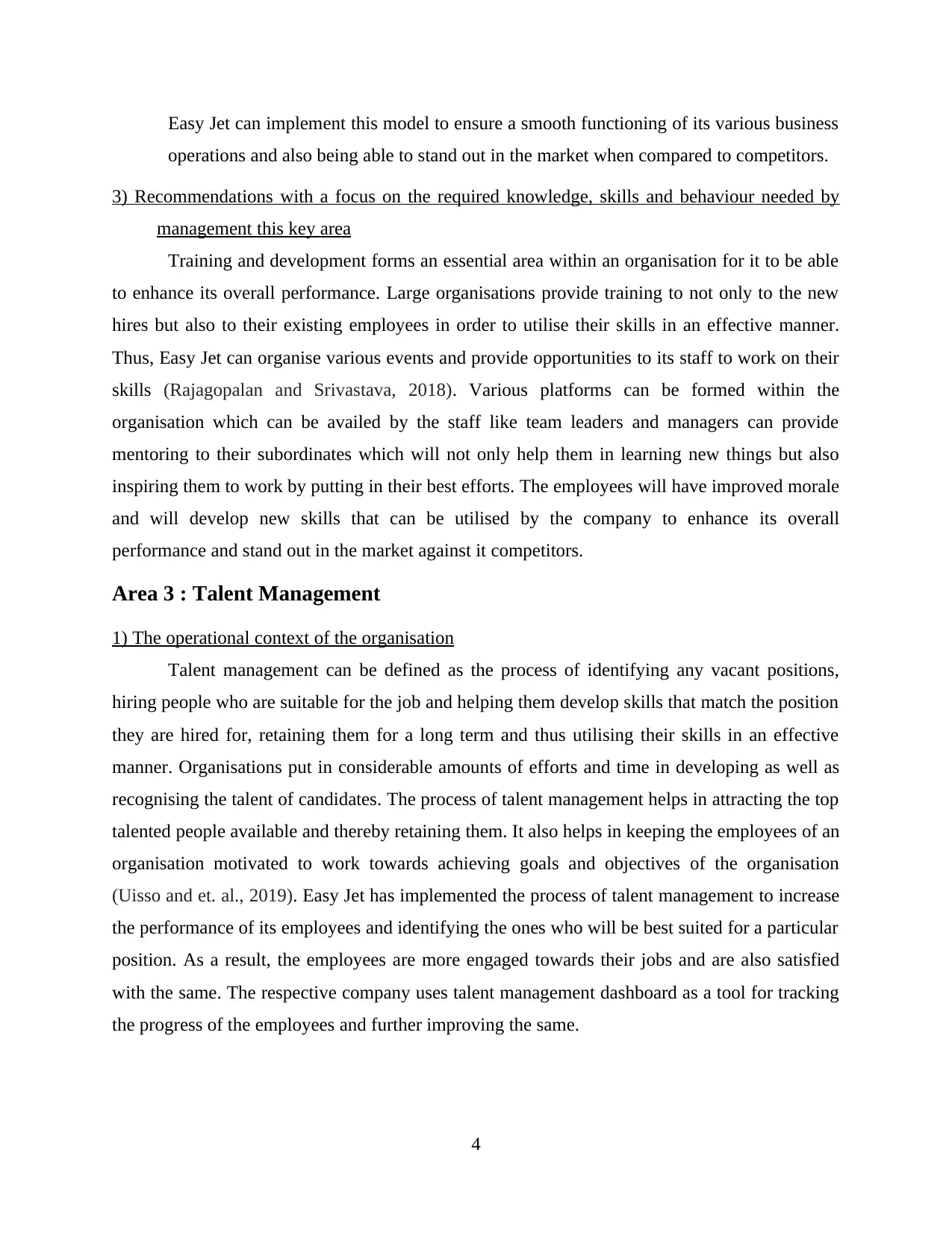
Easy Jet can implement this model to ensure a smooth functioning of its various business
operations and also being able to stand out in the market when compared to competitors.
3) Recommendations with a focus on the required knowledge, skills and behaviour needed by
management this key area
Training and development forms an essential area within an organisation for it to be able
to enhance its overall performance. Large organisations provide training to not only to the new
hires but also to their existing employees in order to utilise their skills in an effective manner.
Thus, Easy Jet can organise various events and provide opportunities to its staff to work on their
skills (Rajagopalan and Srivastava, 2018). Various platforms can be formed within the
organisation which can be availed by the staff like team leaders and managers can provide
mentoring to their subordinates which will not only help them in learning new things but also
inspiring them to work by putting in their best efforts. The employees will have improved morale
and will develop new skills that can be utilised by the company to enhance its overall
performance and stand out in the market against it competitors.
Area 3 : Talent Management
1) The operational context of the organisation
Talent management can be defined as the process of identifying any vacant positions,
hiring people who are suitable for the job and helping them develop skills that match the position
they are hired for, retaining them for a long term and thus utilising their skills in an effective
manner. Organisations put in considerable amounts of efforts and time in developing as well as
recognising the talent of candidates. The process of talent management helps in attracting the top
talented people available and thereby retaining them. It also helps in keeping the employees of an
organisation motivated to work towards achieving goals and objectives of the organisation
(Uisso and et. al., 2019). Easy Jet has implemented the process of talent management to increase
the performance of its employees and identifying the ones who will be best suited for a particular
position. As a result, the employees are more engaged towards their jobs and are also satisfied
with the same. The respective company uses talent management dashboard as a tool for tracking
the progress of the employees and further improving the same.
4
operations and also being able to stand out in the market when compared to competitors.
3) Recommendations with a focus on the required knowledge, skills and behaviour needed by
management this key area
Training and development forms an essential area within an organisation for it to be able
to enhance its overall performance. Large organisations provide training to not only to the new
hires but also to their existing employees in order to utilise their skills in an effective manner.
Thus, Easy Jet can organise various events and provide opportunities to its staff to work on their
skills (Rajagopalan and Srivastava, 2018). Various platforms can be formed within the
organisation which can be availed by the staff like team leaders and managers can provide
mentoring to their subordinates which will not only help them in learning new things but also
inspiring them to work by putting in their best efforts. The employees will have improved morale
and will develop new skills that can be utilised by the company to enhance its overall
performance and stand out in the market against it competitors.
Area 3 : Talent Management
1) The operational context of the organisation
Talent management can be defined as the process of identifying any vacant positions,
hiring people who are suitable for the job and helping them develop skills that match the position
they are hired for, retaining them for a long term and thus utilising their skills in an effective
manner. Organisations put in considerable amounts of efforts and time in developing as well as
recognising the talent of candidates. The process of talent management helps in attracting the top
talented people available and thereby retaining them. It also helps in keeping the employees of an
organisation motivated to work towards achieving goals and objectives of the organisation
(Uisso and et. al., 2019). Easy Jet has implemented the process of talent management to increase
the performance of its employees and identifying the ones who will be best suited for a particular
position. As a result, the employees are more engaged towards their jobs and are also satisfied
with the same. The respective company uses talent management dashboard as a tool for tracking
the progress of the employees and further improving the same.
4
Paraphrase This Document
Need a fresh take? Get an instant paraphrase of this document with our AI Paraphraser
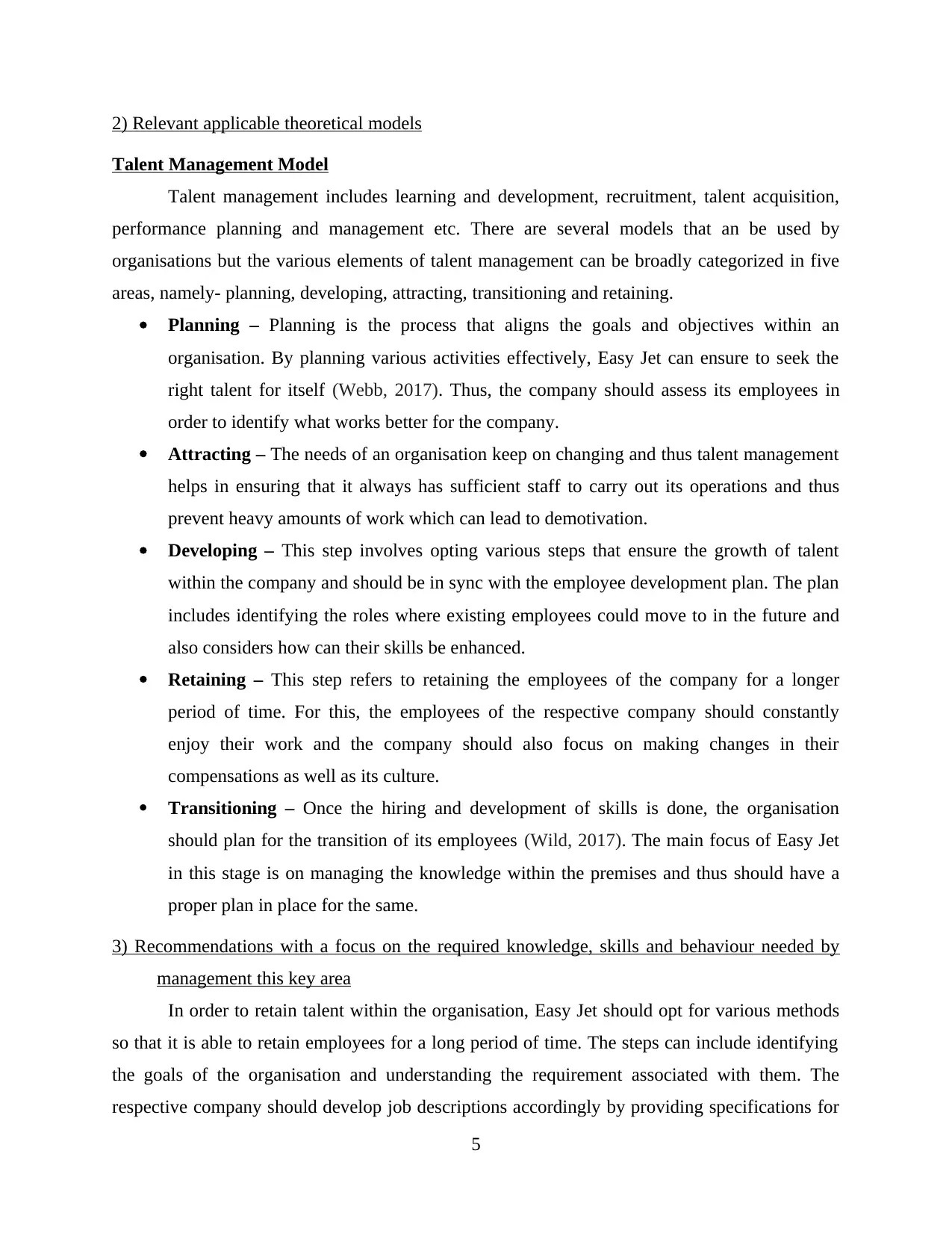
2) Relevant applicable theoretical models
Talent Management Model
Talent management includes learning and development, recruitment, talent acquisition,
performance planning and management etc. There are several models that an be used by
organisations but the various elements of talent management can be broadly categorized in five
areas, namely- planning, developing, attracting, transitioning and retaining.
Planning – Planning is the process that aligns the goals and objectives within an
organisation. By planning various activities effectively, Easy Jet can ensure to seek the
right talent for itself (Webb, 2017). Thus, the company should assess its employees in
order to identify what works better for the company.
Attracting – The needs of an organisation keep on changing and thus talent management
helps in ensuring that it always has sufficient staff to carry out its operations and thus
prevent heavy amounts of work which can lead to demotivation.
Developing – This step involves opting various steps that ensure the growth of talent
within the company and should be in sync with the employee development plan. The plan
includes identifying the roles where existing employees could move to in the future and
also considers how can their skills be enhanced.
Retaining – This step refers to retaining the employees of the company for a longer
period of time. For this, the employees of the respective company should constantly
enjoy their work and the company should also focus on making changes in their
compensations as well as its culture.
Transitioning – Once the hiring and development of skills is done, the organisation
should plan for the transition of its employees (Wild, 2017). The main focus of Easy Jet
in this stage is on managing the knowledge within the premises and thus should have a
proper plan in place for the same.
3) Recommendations with a focus on the required knowledge, skills and behaviour needed by
management this key area
In order to retain talent within the organisation, Easy Jet should opt for various methods
so that it is able to retain employees for a long period of time. The steps can include identifying
the goals of the organisation and understanding the requirement associated with them. The
respective company should develop job descriptions accordingly by providing specifications for
5
Talent Management Model
Talent management includes learning and development, recruitment, talent acquisition,
performance planning and management etc. There are several models that an be used by
organisations but the various elements of talent management can be broadly categorized in five
areas, namely- planning, developing, attracting, transitioning and retaining.
Planning – Planning is the process that aligns the goals and objectives within an
organisation. By planning various activities effectively, Easy Jet can ensure to seek the
right talent for itself (Webb, 2017). Thus, the company should assess its employees in
order to identify what works better for the company.
Attracting – The needs of an organisation keep on changing and thus talent management
helps in ensuring that it always has sufficient staff to carry out its operations and thus
prevent heavy amounts of work which can lead to demotivation.
Developing – This step involves opting various steps that ensure the growth of talent
within the company and should be in sync with the employee development plan. The plan
includes identifying the roles where existing employees could move to in the future and
also considers how can their skills be enhanced.
Retaining – This step refers to retaining the employees of the company for a longer
period of time. For this, the employees of the respective company should constantly
enjoy their work and the company should also focus on making changes in their
compensations as well as its culture.
Transitioning – Once the hiring and development of skills is done, the organisation
should plan for the transition of its employees (Wild, 2017). The main focus of Easy Jet
in this stage is on managing the knowledge within the premises and thus should have a
proper plan in place for the same.
3) Recommendations with a focus on the required knowledge, skills and behaviour needed by
management this key area
In order to retain talent within the organisation, Easy Jet should opt for various methods
so that it is able to retain employees for a long period of time. The steps can include identifying
the goals of the organisation and understanding the requirement associated with them. The
respective company should develop job descriptions accordingly by providing specifications for
5
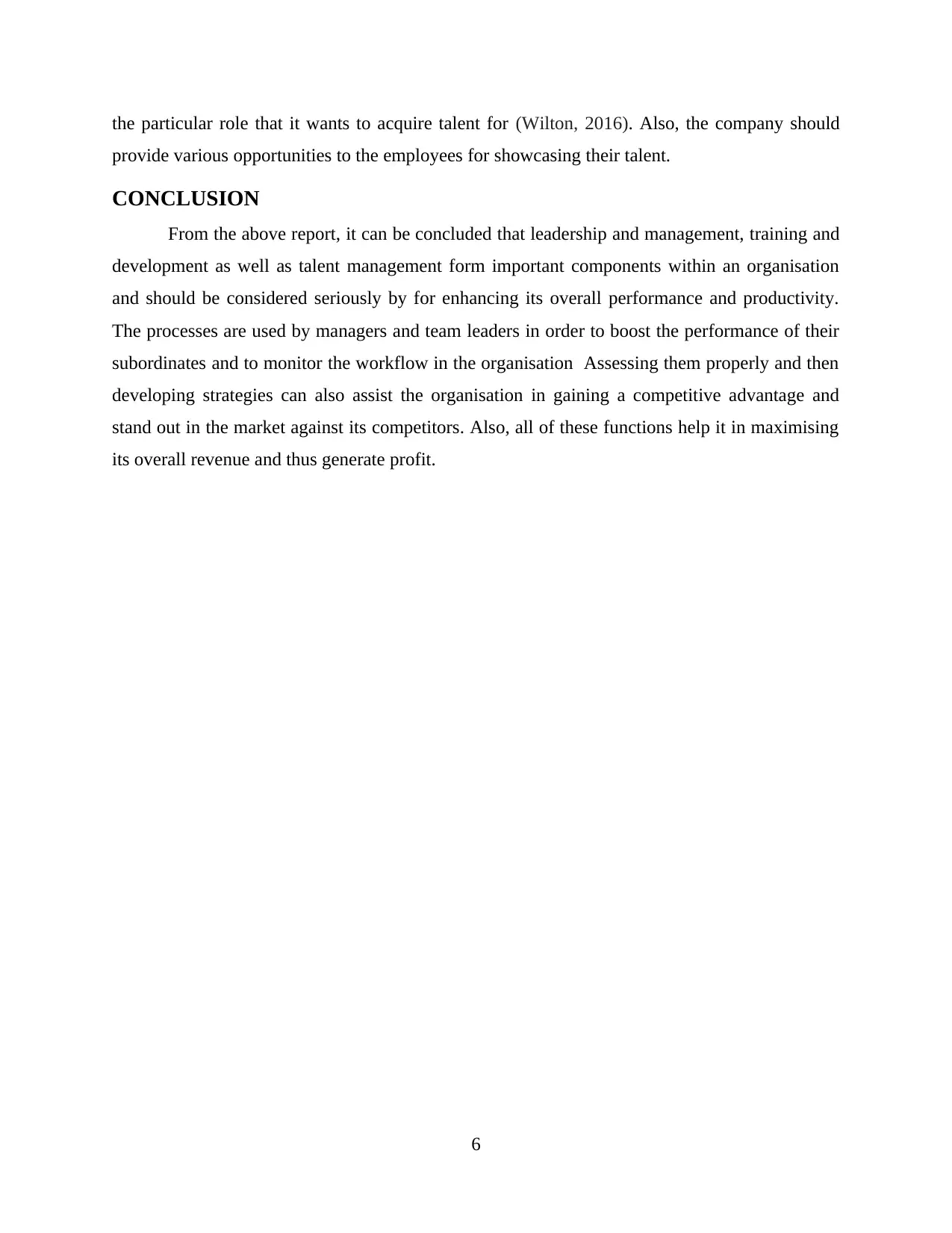
the particular role that it wants to acquire talent for (Wilton, 2016). Also, the company should
provide various opportunities to the employees for showcasing their talent.
CONCLUSION
From the above report, it can be concluded that leadership and management, training and
development as well as talent management form important components within an organisation
and should be considered seriously by for enhancing its overall performance and productivity.
The processes are used by managers and team leaders in order to boost the performance of their
subordinates and to monitor the workflow in the organisation Assessing them properly and then
developing strategies can also assist the organisation in gaining a competitive advantage and
stand out in the market against its competitors. Also, all of these functions help it in maximising
its overall revenue and thus generate profit.
6
provide various opportunities to the employees for showcasing their talent.
CONCLUSION
From the above report, it can be concluded that leadership and management, training and
development as well as talent management form important components within an organisation
and should be considered seriously by for enhancing its overall performance and productivity.
The processes are used by managers and team leaders in order to boost the performance of their
subordinates and to monitor the workflow in the organisation Assessing them properly and then
developing strategies can also assist the organisation in gaining a competitive advantage and
stand out in the market against its competitors. Also, all of these functions help it in maximising
its overall revenue and thus generate profit.
6
⊘ This is a preview!⊘
Do you want full access?
Subscribe today to unlock all pages.

Trusted by 1+ million students worldwide
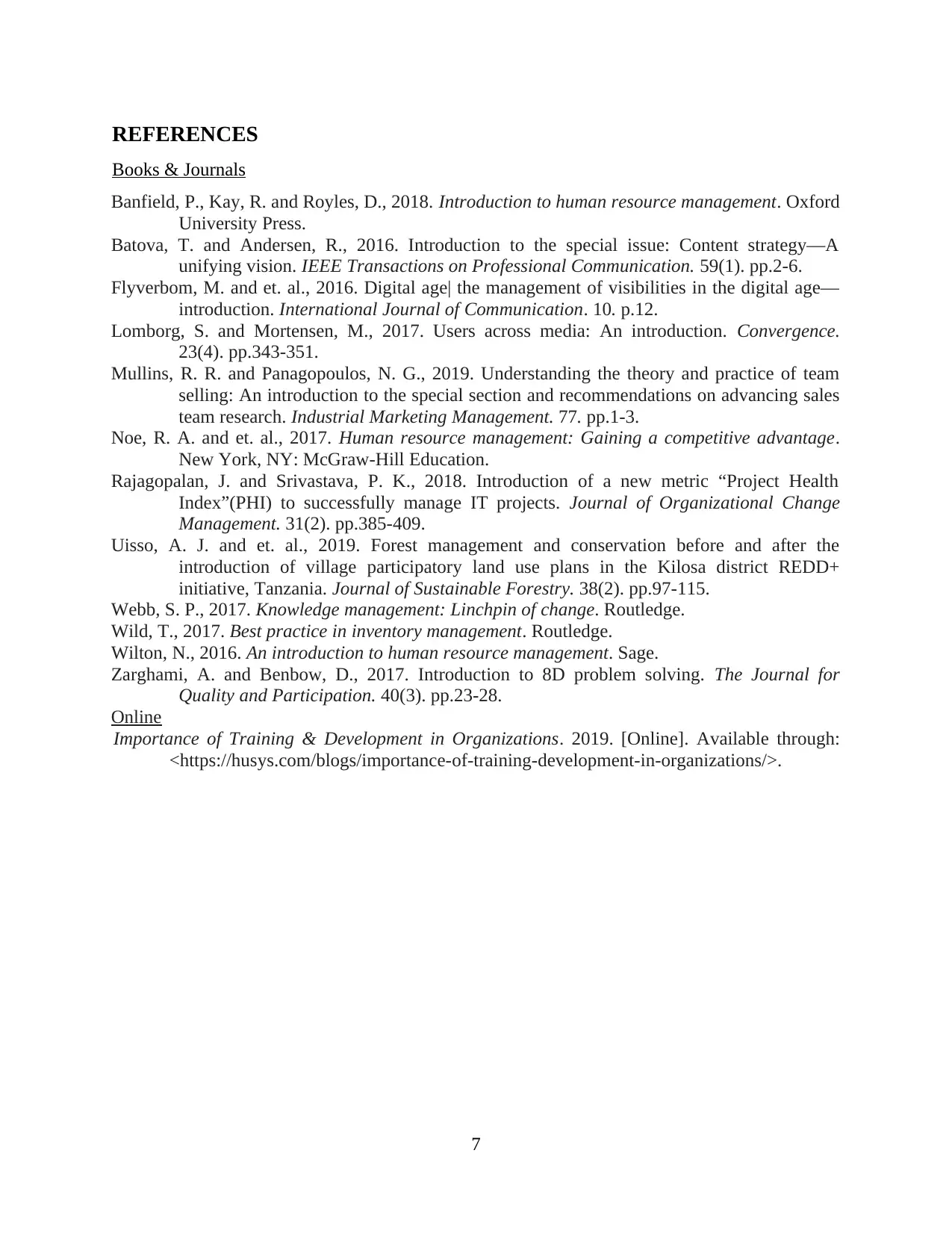
REFERENCES
Books & Journals
Banfield, P., Kay, R. and Royles, D., 2018. Introduction to human resource management. Oxford
University Press.
Batova, T. and Andersen, R., 2016. Introduction to the special issue: Content strategy—A
unifying vision. IEEE Transactions on Professional Communication. 59(1). pp.2-6.
Flyverbom, M. and et. al., 2016. Digital age| the management of visibilities in the digital age—
introduction. International Journal of Communication. 10. p.12.
Lomborg, S. and Mortensen, M., 2017. Users across media: An introduction. Convergence.
23(4). pp.343-351.
Mullins, R. R. and Panagopoulos, N. G., 2019. Understanding the theory and practice of team
selling: An introduction to the special section and recommendations on advancing sales
team research. Industrial Marketing Management. 77. pp.1-3.
Noe, R. A. and et. al., 2017. Human resource management: Gaining a competitive advantage.
New York, NY: McGraw-Hill Education.
Rajagopalan, J. and Srivastava, P. K., 2018. Introduction of a new metric “Project Health
Index”(PHI) to successfully manage IT projects. Journal of Organizational Change
Management. 31(2). pp.385-409.
Uisso, A. J. and et. al., 2019. Forest management and conservation before and after the
introduction of village participatory land use plans in the Kilosa district REDD+
initiative, Tanzania. Journal of Sustainable Forestry. 38(2). pp.97-115.
Webb, S. P., 2017. Knowledge management: Linchpin of change. Routledge.
Wild, T., 2017. Best practice in inventory management. Routledge.
Wilton, N., 2016. An introduction to human resource management. Sage.
Zarghami, A. and Benbow, D., 2017. Introduction to 8D problem solving. The Journal for
Quality and Participation. 40(3). pp.23-28.
Online
Importance of Training & Development in Organizations. 2019. [Online]. Available through:
<https://husys.com/blogs/importance-of-training-development-in-organizations/>.
7
Books & Journals
Banfield, P., Kay, R. and Royles, D., 2018. Introduction to human resource management. Oxford
University Press.
Batova, T. and Andersen, R., 2016. Introduction to the special issue: Content strategy—A
unifying vision. IEEE Transactions on Professional Communication. 59(1). pp.2-6.
Flyverbom, M. and et. al., 2016. Digital age| the management of visibilities in the digital age—
introduction. International Journal of Communication. 10. p.12.
Lomborg, S. and Mortensen, M., 2017. Users across media: An introduction. Convergence.
23(4). pp.343-351.
Mullins, R. R. and Panagopoulos, N. G., 2019. Understanding the theory and practice of team
selling: An introduction to the special section and recommendations on advancing sales
team research. Industrial Marketing Management. 77. pp.1-3.
Noe, R. A. and et. al., 2017. Human resource management: Gaining a competitive advantage.
New York, NY: McGraw-Hill Education.
Rajagopalan, J. and Srivastava, P. K., 2018. Introduction of a new metric “Project Health
Index”(PHI) to successfully manage IT projects. Journal of Organizational Change
Management. 31(2). pp.385-409.
Uisso, A. J. and et. al., 2019. Forest management and conservation before and after the
introduction of village participatory land use plans in the Kilosa district REDD+
initiative, Tanzania. Journal of Sustainable Forestry. 38(2). pp.97-115.
Webb, S. P., 2017. Knowledge management: Linchpin of change. Routledge.
Wild, T., 2017. Best practice in inventory management. Routledge.
Wilton, N., 2016. An introduction to human resource management. Sage.
Zarghami, A. and Benbow, D., 2017. Introduction to 8D problem solving. The Journal for
Quality and Participation. 40(3). pp.23-28.
Online
Importance of Training & Development in Organizations. 2019. [Online]. Available through:
<https://husys.com/blogs/importance-of-training-development-in-organizations/>.
7
1 out of 10
Related Documents
Your All-in-One AI-Powered Toolkit for Academic Success.
+13062052269
info@desklib.com
Available 24*7 on WhatsApp / Email
![[object Object]](/_next/static/media/star-bottom.7253800d.svg)
Unlock your academic potential
Copyright © 2020–2025 A2Z Services. All Rights Reserved. Developed and managed by ZUCOL.





